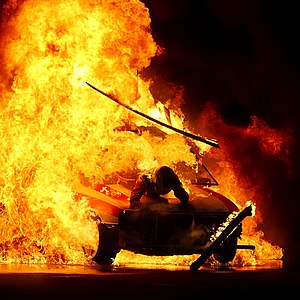Certification
It is becoming more common in different countries and regions for individuals involved with the storage, handling and operation of pyrotechnics to have some form of license or certification. The specific requirements for certification, along with any restrictions or prohibitions, however, can vary wildly from one jurisdiction to the next. Most jurisdictions do require some type of minimum professional fireworks training before being allowed to apply for certification.
Canada
In Canada, individuals using, handling or storing pyrotechnics must receive government certification, administered by the Explosives Regulatory Division of Natural Resources Canada. All individuals must meet certain minimum requirements, including being at least 18 years of age and having received government training, before being issued a license. All pyrotechnicians, of any classification or certification are required to maintain a log of their experience.
Certification for the use of proximate (indoor) pyrotechnics in Canada is separate from certification for display fireworks, and different government training and certification must be obtained.
The available licenses for the use of proximate pyrotechnics are sub-divided into one of 6 categories.
Theatrical User
The Theatrical User classification is intended for individuals who use pyrotechnics as only a minor part of their profession, and have no need for advancement to higher classes of certification. Individuals may use only a severely restricted list of pyrotechnics, and are also subject to significant restrictions as to their application. Certification is valid for one year.
Assistant
The Assistant classification is considered an entry level class for individuals entering the pyrotechnics profession, or who use pyrotechnics in their profession. Individuals may use a restricted list of pyrotechnics individually, but may fabricate, handle, and set-up a broader list of pyrotechnics typically prohibited to the Assistant under the direct supervision of a higher licensed individual. After five years of verifiable experience with a sufficient assortment of pyrotechnics, Assistant level technicians may apply for advancement to Pyrotechnician certification. Certification is valid for one year.
Pyrotechnician
The Pyrotechnician classification is the primary classification in Canada. Individuals may use any pyrotechnic device or product approved for use in Canada, and may also fabricate, handle, and set-up a special purpose or custom fabricated pyrotechnics typically prohibited while under the direct supervision of a Special Effects Technician. After five years of verifiable experience with a sufficient assortment of pyrotechnics, Pyrotechnician's may apply for advancement to Special Effects Technician certification. Certification is valid for one year.
Special Effects Technician
The Special Effects Technician classification is the most advanced classification in Canada. Individuals may use any pyrotechnic device or product approved for use in Canada, and may also fabricate, handle, and set-up a special purpose or custom fabricated pyrotechnics device typically prohibited. A Special Effects Technician may also apply for special certification to use restricted material, such as detonating cord and exploding bolts. Certification is valid for one year.
Authorities Having Jurisdiction
Authorities Having Jurisdiction (AHJ) are individuals certified by the Explosive Regulatory Division to inspect and approve pyrotechnic events, including members of agencies associated with pyrotechnics such as fire departments and police forces. Unlike other certification classes, Authorities Having Jurisdiction are not required to pay a renewal fee, and certification is valid for five years.
Out-of-Country Technicians
Pyrotechnicians based outside of Canada participating in the production of a pyrotechnics special effects event in Canada are required to obtain a Visitor Card at either a Pyrotechnician or Special Effects Technician equivalent level. A certified Canadian technician of the applicable class must also be employed for the production. Visitor Cards are valid for one year.
Alternately, pyrotechnicians based outside of Canada may apply for Canadian certification, provided they meet the minimum requirements and attend the Explosive Regulatory Division certification training.
United States
There is no national certification or licensing requirements for pyrotechnicians in the United States, however, many individual states implement their own certification or licensing programs. Not all states have reciprocity agreements in regards to honouring another states certification, so it is not uncommon for pyrotechnicians to have certifications from multiple states. Certain states require certification to store, handle and operate fireworks but not proximate (indoor) pyrotechnics; other states use the same certification for all pyrotechnics. It is always recommended to confer with local authorities in any jurisdiction to determine local laws and regulations.
Professional pyrotechnic companies typically have licenses issued by the Bureau of Alcohol, Tobacco, Firearms and Explosives with regard to manufacturer and distribution of pyrotechnic materials.











